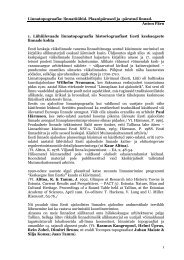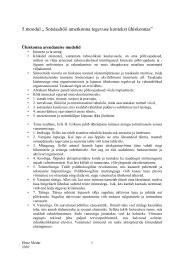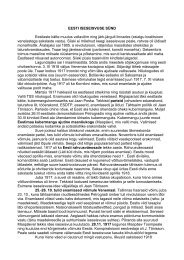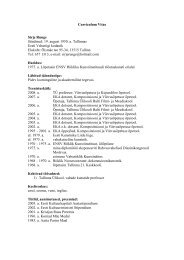crowding and children's mental health: the role of house type
crowding and children's mental health: the role of house type
crowding and children's mental health: the role of house type
You also want an ePaper? Increase the reach of your titles
YUMPU automatically turns print PDFs into web optimized ePapers that Google loves.
226 G. W. Evans et al.<br />
FIGURE 4. Regression <strong>of</strong> residentialdensity onto teacher reports <strong>of</strong><br />
behavioralconduct in <strong>the</strong> classroom as a function <strong>of</strong> housing <strong>type</strong><br />
row <strong>house</strong>s, b = 0?63, t(1093) = 1?35, ns., do not<br />
manifest links between <strong>crowding</strong> <strong>and</strong> behavioral<br />
disturbances at school. Again <strong>the</strong>re are main e¡ects<br />
for density, F (1, 1097) = 5?16, po0?05, DR 2 =0?03 as<br />
well as for <strong>house</strong> <strong>type</strong>, F(2, 1096) = 3.96, po0?05,<br />
DR 2 = 0?01. Children from more crowded homes<br />
have greater levels <strong>of</strong> behavioral disturbance at<br />
school. Children living in multiple-family dwellings<br />
manifest greater behavioraldisturbances at school<br />
than those living ei<strong>the</strong>r in single family or row<br />
<strong>house</strong>s. As for <strong>the</strong> KINDL, all analyses statistically<br />
controlfor mo<strong>the</strong>r’s education.<br />
Discussion<br />
The data in Table 1 provide some evidence for concurrent<br />
validity <strong>of</strong> <strong>the</strong> two indexes <strong>of</strong> children’s psychological<br />
well being, given <strong>the</strong> correlation <strong>of</strong> 0?31<br />
between <strong>the</strong> Needleman scale which is a teacher<br />
rating scale <strong>of</strong> conduct disorder <strong>and</strong> <strong>the</strong> child’s selfreport<br />
(KINDL) <strong>of</strong> emotionalwellbeing <strong>and</strong> functional<br />
impairment. Ideally, one would prefer a higher<br />
degree <strong>of</strong> convergent validation, although <strong>the</strong><br />
level <strong>of</strong> correlation is well in line with expert ratings<br />
<strong>and</strong> middle elementary school children’s self-reports<br />
<strong>of</strong> psychological <strong>health</strong> (Wachs, 1989). Our<br />
degree <strong>of</strong> convergent validity also compares well to<br />
that obtained by <strong>the</strong> originalauthors <strong>of</strong> <strong>the</strong> KINDL<br />
with o<strong>the</strong>r generalassessments <strong>of</strong> children’s <strong>mental</strong><br />
<strong>health</strong> (see discussion above in <strong>the</strong> Methods section).<br />
It is also worth brief mention that <strong>the</strong> Needleman<br />
teacher rating scale correlates at a higher level<br />
with <strong>the</strong> FunctionalImpairment subscale <strong>of</strong> <strong>the</strong><br />
KINDL than it does with <strong>the</strong> EmotionalWellBeing<br />
subscale. Inspection <strong>of</strong> <strong>the</strong> items (see Appendix 1 )<br />
indicates more content overlap between <strong>the</strong> Needleman<br />
scale <strong>and</strong> <strong>the</strong> Functional Impairment subscale<br />
relative to <strong>the</strong> Emotional Well Being subscale.<br />
The primary objective <strong>of</strong> this study was to examine<br />
<strong>the</strong> interaction between <strong>house</strong> <strong>type</strong> <strong>and</strong> density<br />
as <strong>the</strong>y inter-related to children’s <strong>mental</strong> <strong>health</strong>. As<br />
indicated in Figures 1 <strong>and</strong> 2, <strong>the</strong> relations between<br />
residentialdensity <strong>and</strong> psychologicalwellbeing are<br />
moderated by housing <strong>type</strong>. Children who live in<br />
multiple-family dwellings react more strongly to<br />
high-density conditions than those living in ei<strong>the</strong>r<br />
single-family or row <strong>house</strong>s. These results are independent<br />
<strong>of</strong> maternaleducationallevels <strong>and</strong> mo<strong>the</strong>r’s<br />
occupationalstatus is unrelated to <strong>house</strong> <strong>type</strong> or<br />
density. The ¢ndings for <strong>the</strong> child’s self-reported<br />
<strong>mental</strong>wellbeing data indicate that high density<br />
in row <strong>house</strong>s may also be harmful. The teacher ratings,<br />
however, reveala relation between density <strong>and</strong><br />
distress only for children living among multiple<br />
dwelling units.<br />
The interaction <strong>of</strong> housing <strong>type</strong> <strong>and</strong> density<br />
on children’s <strong>mental</strong> <strong>health</strong> adds to <strong>the</strong> small literature<br />
on environ<strong>mental</strong>design <strong>and</strong> <strong>crowding</strong>.<br />
Psychologists studying density have tended to focus<br />
on what direct e¡ects density has on human behavior<br />
as well as on individual di¡erences (e.g. gender,<br />
culture) in response to <strong>crowding</strong> (Baum & Paulus,<br />
1987; Evans, 2001). It is important for environ<strong>mental</strong><br />
psychologists to remember that design variables, similar<br />
to person variables, can function as moderators<br />
<strong>of</strong> psychosocialprocesses. The <strong>role</strong> <strong>of</strong> design<br />
not only as a direct precipitant <strong>of</strong> behavior but also<br />
as a factor that can alter how <strong>the</strong> human^environment<br />
system works has not been su⁄ciently developed.<br />
Design can help people cope with certain<br />
undesirable psychosocial conditions or it can exacerbate<br />
<strong>the</strong>ir harmfulimpacts. The present data<br />
along with previous research led to <strong>the</strong> prediction<br />
that high-density living will be better tolerated<br />
when children live in smaller dwellings, preferably<br />
detached units; when <strong>the</strong>y have a room <strong>of</strong> <strong>the</strong>ir<br />
own or at least a designated playspace where <strong>the</strong>y<br />
can be alone (Wachs & Gruen, 1982); when <strong>the</strong>ir residence<br />
is designed in such a way as to minimize uncontrollable<br />
social interactions (Baum & Valins,<br />
1977, 1979); <strong>and</strong> when £oorplans layouts provide<br />
better separation <strong>of</strong> rooms from one ano<strong>the</strong>r (Evans<br />
et al., 1996).


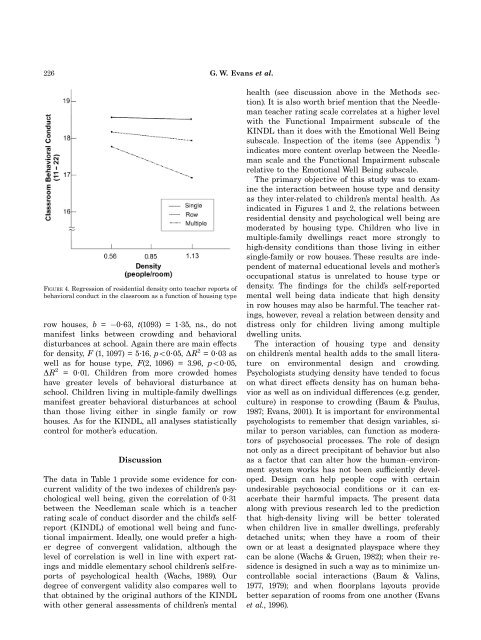
![5 Verben 2 S[1]. 35-44.pdf](https://img.yumpu.com/27096544/1/184x260/5-verben-2-s1-35-44pdf.jpg?quality=85)

